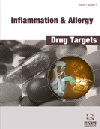- Home
- A-Z Publications
- Inflammation & Allergy-Drug Targets (Discontinued)
- Previous Issues
- Volume 10, Issue 3, 2011
Inflammation & Allergy-Drug Targets (Discontinued) - Volume 10, Issue 3, 2011
Volume 10, Issue 3, 2011
-
-
Nasal Polyposis: From Pathogenesis to Treatment, An Update
More LessNasal polyps (NP) are common benign degeneration of nasal sinus mucosa with a prevalence around 4% in the adult population. The causes are still uncertain but there is a strong association with allergy, infection, asthma and aspirin sensitivity. Histologically, the presence of a large quantity of extracellular fluid, mast cell degranulation and eosinophilia has been demonstrated. Typically the patients show nasal obstruction, ano Read More
-
-
-
Skin Prick Test with Self-Saliva in Patients with Oral Aphthoses: A New Diagnostic Pathergy for Behcet's Disease and Recurrent Aphthosis
More LessAuthors: Ari Togashi, Sanae Saito, Fumio Kaneko, Koichiro Nakamura and Noritaka OyamaThere may be some difficulties to differentiate Behcet's disease (BD), recurrent aphthosis (RA), and herpetic aphthous ulceration, from other mimicking oral disorders. Despite of unexpected sensitivity and responsiveness, the skin pathergy test regarding a non-specific hypersensitivity has long been thought as one of auxiliary diagnostic benefits for BD. To determine the potential usefulness and disease specificity of the pric Read More
-
-
-
Double-Stranded RNA Induces MMP-9 Gene Expression in HaCaT Keratinocytes by Tumor Necrosis Factor-α
More LessAuthors: Andreas Voss, Kirsten Gescher, Andreas Hensel, Wolfgang Nacken and Claus KerkhoffViral double-stranded RNA (dsRNA) and its synthetic analog poly(I:C) are recognized via multiple pathways and induce the expression of genes related to inflammation. In the present study, we demonstrate that poly(I:C) specifically induced the expression of matrix metalloproteinase-9 (MMP-9) in HaCaT keratinocytes. Studies using specific pharmacological inhibitors revealed the involvement of NF-κB, p38 MAPK, and PI- Read More
-
-
-
Biology of the Interleukin-9 Pathway and its Therapeutic Potential for the Treatment of Asthma
More LessAuthors: Chad K. Oh, Donald Raible, Gregory P. Geba and Nestor A. MolfinoAsthma is a complex disease characterized by variable airflow limitation, hyperresponsiveness, and airways inflammation. Despite valuable therapeutic advances to control asthma symptoms in the last decade, a quantifiable proportion of patients with moderate to severe asthma continue to experience inadequate disease control, highlighting an important unmet need. In animal models of asthma, interleukin (IL)-9 Read More
-
-
-
Interleukin-25 Negatively Controls Pathogenic Responses in the Gut
More LessAlthough interleukin-25 (IL-25) has been traditionally considered as a cytokine involved in T helper (Th) 2 cell-associated allergic diseases and host defence against helminthic parasites, recent studies have shown that IL-25 exerts negative effects on the initiation and progression of Th1/Th17-mediated pathologies. This later function of IL-25 is particularly evident at the gut level, where IL-25 could contribute to attenuate tissue Read More
-
-
-
Immunologic Diseases and Brain Tumors
More LessTo do a bibliographic review of the given association of atopic [AD] and immunological diseases with central nerve system tumors [CNST] described a few years ago and to know the knowledge available. It gives an overview of the studies describing this association, and those explaining its mechanism. A negative association of AD with CNST stands out in case-control studies, which is not observed in cohort studies. The grea Read More
-
-
-
Toll-Like Receptors: Role in Inflammation and Commensal Bacteria
More LessTLR ligands are present on both commensal and pathogenic microbes. Intestinal epithelial cells (IECs) have been observed to be largely unresponsive to TLR ligands. This observation has partly been explained by the fact that TLR expression on IECs is sparse. The discovery of the Toll-like receptors finally identified the innate immune receptors that were responsible for many of the innate immune functions that had be Read More
-
-
-
NF-κB in Type 1 Diabetes
More LessType 1 diabetes is an autoimmune disease in which pancreatic beta cells are destroyed by autoreactive T cells. It is a common pediatric disease with increasing incidence. Islet transplantation may be a therapeutic option, however, the current limitations of this procedure mean that for most sufferers of type 1 diabetes there is no cure. The transcription factor NF-κB has been widely studied for its role in development of type 1 Read More
-
-
-
Regulation of Inflammation and Myocardial Fibrosis in Experimental Autoimmune Myocarditis
More LessAutoimmune responses and inflammation are involved in the pathogenesis of many cardiovascular diseases. There is compelling evidence that inflammatory mechanisms may contribute to progressive heart failure. Thus, myocardial infiltration of lymphocytes and mononuclear cells, increased expression of pro-inflammatory chemokines and cytokines and circulating autoantibodies are frequently observed in myocard Read More
-
Most Read This Month
Article
content/journals/iadt
Journal
10
5
false
en


